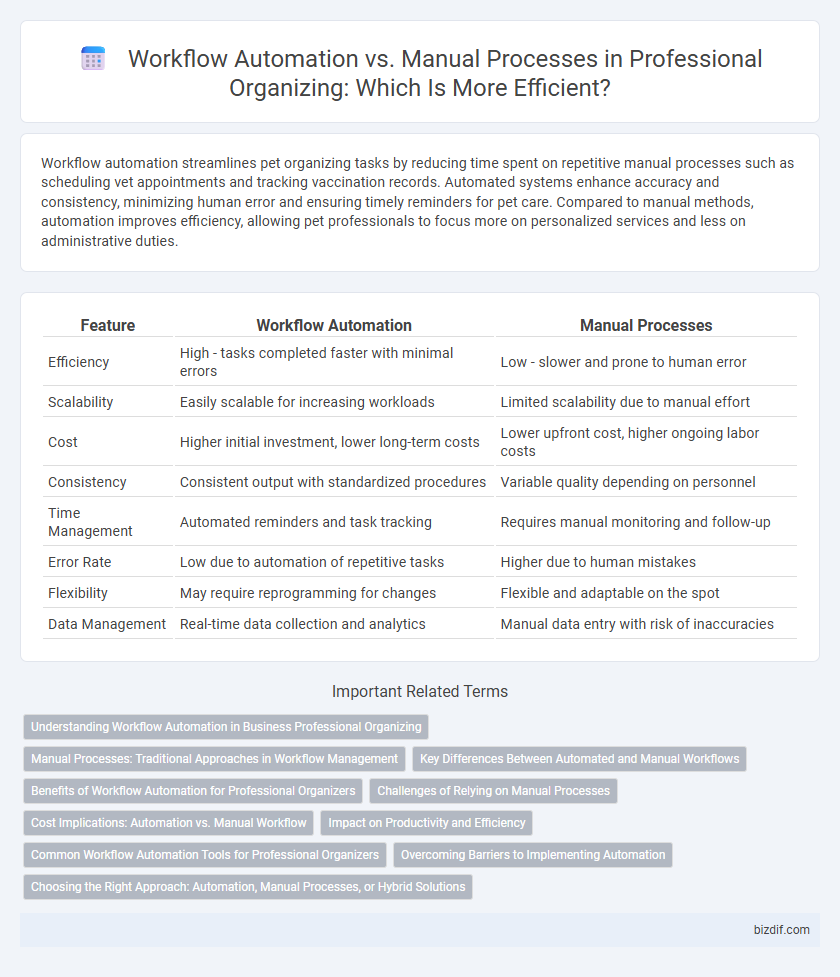Workflow automation streamlines pet organizing tasks by reducing time spent on repetitive manual processes such as scheduling vet appointments and tracking vaccination records. Automated systems enhance accuracy and consistency, minimizing human error and ensuring timely reminders for pet care. Compared to manual methods, automation improves efficiency, allowing pet professionals to focus more on personalized services and less on administrative duties.
Table of Comparison
| Feature | Workflow Automation | Manual Processes |
|---|---|---|
| Efficiency | High - tasks completed faster with minimal errors | Low - slower and prone to human error |
| Scalability | Easily scalable for increasing workloads | Limited scalability due to manual effort |
| Cost | Higher initial investment, lower long-term costs | Lower upfront cost, higher ongoing labor costs |
| Consistency | Consistent output with standardized procedures | Variable quality depending on personnel |
| Time Management | Automated reminders and task tracking | Requires manual monitoring and follow-up |
| Error Rate | Low due to automation of repetitive tasks | Higher due to human mistakes |
| Flexibility | May require reprogramming for changes | Flexible and adaptable on the spot |
| Data Management | Real-time data collection and analytics | Manual data entry with risk of inaccuracies |
Understanding Workflow Automation in Business Professional Organizing
Workflow automation in business professional organizing streamlines repetitive tasks by utilizing software tools to manage scheduling, client communications, and document handling, significantly increasing productivity and accuracy. Manual processes require continuous human input, which often leads to errors and inefficiencies, whereas automated workflows reduce time spent on routine activities, allowing organizers to focus on strategic client services. Integrating workflow automation enhances task prioritization, improves consistency across projects, and provides real-time tracking of progress critical for client satisfaction and business growth.
Manual Processes: Traditional Approaches in Workflow Management
Manual processes in workflow management rely on human intervention for task execution, tracking, and coordination, often leading to increased errors and slower turnaround times. Traditional approaches include paper-based records, spreadsheets, and manual communication that limit scalability and transparency. Despite their familiarity, these methods can hinder efficiency, making it challenging to maintain consistency and meet tight deadlines in professional organizing.
Key Differences Between Automated and Manual Workflows
Automated workflows streamline tasks by using software tools to execute repetitive actions with higher accuracy and speed compared to manual processes. Manual workflows rely heavily on human intervention, which increases the risk of errors and consumes more time, affecting overall productivity. Key differences include consistency, scalability, error reduction, and the ability to handle complex operations without continuous oversight in automated systems.
Benefits of Workflow Automation for Professional Organizers
Workflow automation revolutionizes professional organizing by significantly reducing time spent on repetitive tasks, increasing overall efficiency and accuracy. It enables seamless task delegation, progress tracking, and client communication, freeing organizers to focus on personalized service and strategic planning. Automated workflows minimize human error and ensure consistent, professional delivery, enhancing client satisfaction and business scalability.
Challenges of Relying on Manual Processes
Relying on manual processes in professional organizing often leads to inefficiencies, increased errors, and inconsistent task execution. Manual documentation and scheduling consume significant time, reducing overall productivity and increasing the risk of missed deadlines. Workflow automation eliminates these challenges by streamlining repetitive tasks, ensuring accuracy, and enabling real-time tracking of organizational projects.
Cost Implications: Automation vs. Manual Workflow
Workflow automation significantly reduces labor costs by minimizing repetitive manual tasks and accelerating project timelines in professional organizing. Manual processes often incur higher expenses due to increased time investment and potential for human error, leading to inefficiencies and added corrective work. Investing in automation tools delivers long-term cost savings, enhances accuracy, and maximizes resource allocation in organizing projects.
Impact on Productivity and Efficiency
Workflow automation enhances productivity and efficiency by streamlining repetitive tasks, reducing human error, and enabling faster completion of projects. Manual processes often slow down operations, increase the risk of mistakes, and consume valuable time that could be allocated to strategic organizing activities. Implementing automation tools significantly boosts time management and task accuracy in professional organizing.
Common Workflow Automation Tools for Professional Organizers
Workflow automation tools like Trello, Asana, and Zapier streamline task management, client communication, and scheduling for professional organizers, enhancing productivity and reducing errors compared to manual processes. These platforms integrate multiple services, allowing automated reminders, project tracking, and real-time collaboration, which manual methods often lack. Utilizing automation tools significantly cuts down administrative time, enabling organizers to focus more on client-centric activities and improving overall operational efficiency.
Overcoming Barriers to Implementing Automation
Workflow automation enhances efficiency by reducing repetitive manual tasks, yet professionals often face barriers such as high initial setup costs, technical complexity, and resistance to change among staff. Overcoming these challenges requires targeted training, scalable automation tools tailored to specific organizational needs, and a phased implementation strategy to build confidence and demonstrate value. Leveraging clear communication and continuous support helps ease the transition from manual processes to automated workflows.
Choosing the Right Approach: Automation, Manual Processes, or Hybrid Solutions
Selecting the right approach between workflow automation, manual processes, or hybrid solutions depends on task complexity, volume, and consistency requirements. Automation is ideal for repetitive, high-volume tasks that demand accuracy and speed, reducing errors and saving time. Hybrid solutions combine human oversight with automated tools, offering flexibility for nuanced decisions while maintaining efficiency in professional organizing workflows.
workflow automation vs manual processes Infographic

 bizdif.com
bizdif.com